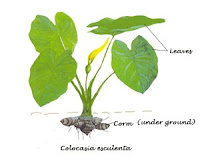

English Name: Colocasia
Common Indian Name (Hindi): Arbi or Ghuiya / Patra
- Colocasia esculenta is a tropical herbaceous perennial plant, primarily grown for its edible corm and secondarily as a leaf vegetable. In Indian subcontinent its leaves are cherished.
- A corm is a short, vertical, swollen underground plant stem that serves as a storage organ used by some plants to survive winter or other adverse conditions such as summer drought and heat.
- In North India, it is called Arvi or Arbi. In Assamese it is called Kosu. In Bengali the root is called gath and the plant is called Kochu.
- The leaves are large to very large, 20-150 cm long, with a sagittate shape. The elephant's-ear plant gets its name from the leaves, which are shaped like a large ear or shield. In the Indian state of Gujarat it is used to make patra, a dish with the leaves of the plant prepared with tamarind and other spices.
- In its raw form the plant is toxic due to the presence of calcium oxalate, and the presence of needle-shaped raphides in the plant cells. However, the toxin can be destroyed and the tuber rendered palatable by cooking, or by steeping in cold water overnight.
- Typical of leaf vegetables, arbi/arvee leaves are rich in vitamins and minerals. They are a good source of thiamine, riboflavin, iron, phosphorus, potassium, copper, manganese and zinc. Corms are very high in starch, and are a good source of dietary fibers.
- Oxalic acid may be present in the corm and especially in the leaf. Calcium reacts with the oxalate to form calcium oxalate, which is highly insoluble and is suspected to cause kidney stones by obstructing kidney tubules. Healthy individuals can safely consume such foods in moderation, but those with kidney disorders, gout, rheumatoid arthritis, or certain forms of chronic vulvar pain are typically advised to avoid foods high in oxalic acid or oxalates.
- Care must be taken to oil one's hands before handling the leaves, as some leaves are acidic and cause scratching. The leaves are completely safe and delicious after cooking.

No comments:
Post a Comment